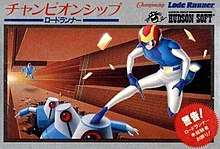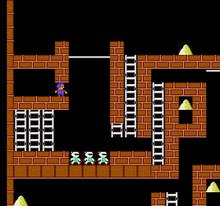| Championship Lode Runner | |
|---|---|
 Famicom cover art Famicom cover art | |
| Developer(s) | Broderbund Compile (SG-1000, MSX) |
| Publisher(s) | Broderbund Hudson Soft (Famicom) Sega (SG-1000) Sony (MSX) |
| Designer(s) | Doug Smith |
| Programmer(s) | IBM PC Doug Greene Famicom Shinichi Nakamoto |
| Composer(s) | Isamu Hirano (Famicom) |
| Series | Lode Runner |
| Platform(s) | Apple II, Atari 8-bit, Commodore 64, IBM PC, Famicom, MSX, SG-1000 |
| Release | 1984: Apple, C64, IBM PC 1985: Atari 8-bit, Famicom, SG-1000 1986: MSX |
| Genre(s) | Puzzle-platform |
| Mode(s) | Single-player |
Championship Lode Runner is a sequel to the 1983 puzzle-platform game Lode Runner. It was released in 1984 for the Apple II, Commodore 64, and IBM PC (as a self-booting disk), then ported to the Atari 8-bit computers, Famicom, SG-1000, and MSX. Mostly the same as Lode Runner, Championship Lode Runner has levels that are much more difficult. Unlike the original, it does not include a level editor.
Gameplay

The object of the game is to pick up all the gold pieces (which appear as piles of gold) and get them to the top. Using non-violent methods, enemies had to be overcome. Bumping into enemies cost the player a life and all of their hard-earned gold pieces. Fifty of the hardest levels ever designed are used and they had to be tackled in proper sequential order. While games can be saved, the player automatically loses a life for restoring the game.
Unlike the original Lode Runner game, this version does not come with a level editor. Many of the levels made for this game were designed using the built-in level editor from the original game.
Ports
The game was first released for the Apple II. The Famicom port of the game was published by Hudson Soft. Famicom players can start at any of the first ten levels while needing passwords to skip to the next levels. The Apple II version and Famicom offered players a certificate for completing the game.
The IBM PC self-booting disk version was written by Doug Greene.
In 1985, Sega published the game for the SG-1000 in Japan and it was released on the My Card format. A port was also released for the MSX. Both versions were developed by Compile.
Reception
Based on sales and market-share data, Video magazine listed the game seventh on its list of best selling video games in February 1985.
Ahoy! in 1986 agreed with the box's warning of Championship Lode Runner's difficulty and advised even expert players to obtain the hint book, because each of the 50 levels would require twice as much time as the original game's most-difficult.
Reviews
- Games #61
References
- "Advanced game overview". Gamasutra. Retrieved 2010-06-08.
- ^ Grannell, Craig (January 2013). "Lode Runner". Retro Gamer (111): 24.
- "ソフトウェア一覧: SG-1000". Sega. Retrieved 2020-01-19.
- "COMPILE GAME HISTORY -SG-1000-". Compile. Archived from the original on 2002-10-03. Retrieved 2020-01-19.
- "COMPILE GAME HISTORY -MSX-". Compile. Archived from the original on 2002-10-03. Retrieved 2020-01-19.
- Ditlea, Steve; Onosco, Tim; Kunkel, Bill (February 1985). "Random Access: Best Sellers/Recreation". Video. 8 (11). Reese Communications: 35. ISSN 0147-8907.
- Kunkel, Bill; Katz, Arnie (April 1986). "Think Fast! Action-Strategy Games for the Commodore 64". Ahoy!. pp. 41–45. Retrieved 2024-09-04.
- "GAMES Magazine #61". March 1985.
External links
| Lode Runner series | |
|---|---|
| 1980s | |
| Later games | |
| People | |
- 1984 video games
- Apple II games
- Atari 8-bit computer games
- Broderbund games
- Commodore 64 games
- Hudson Soft games
- MSX games
- Nintendo Entertainment System games
- Puzzle-platformers
- Video game sequels
- Video games developed in the United States
- Virtual Console games
- Virtual Console games for Wii U
- SG-1000 games
- Single-player video games